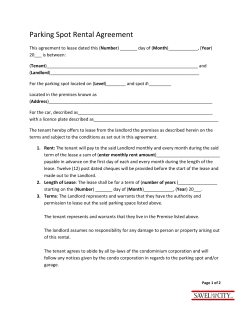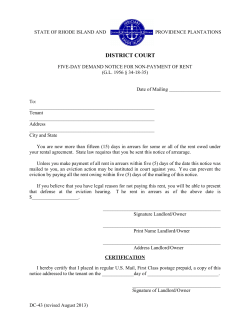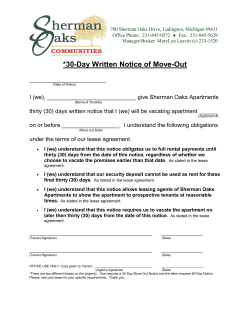
Retail Bankruptcy: How to Prepare and Survive March 25
Retail Bankruptcy: How to Prepare and Survive March 25th, 2009 CORPORATE FINANCE Retailer’s Perspective on Dealing With Recession March 25, 2009 ADVISORY CURRENT MARKET DYNAMIC Statistics: - GDP - Housing market - Unemployment rate - Consumer confidence - Retail sales - Stock market Real estate market - Few if any retailers expanding - More retailers contracting or going into bankruptcy © 2009 KPMG Corporate Finance LLC, a U.S. limited liability company, is a member of FINRA and is registered as a broker dealer with the SEC. KPMG Corporate Finance LLC is a subsidiary of KPMG LLP, a UK limited liability partnership and the UK member firm of the KPMG network of independent member firms affiliated with KPMG International, a Swiss cooperative. FIRST MEETING WITH RETAILER – BUSINESS ISSUES Comp store sales Liquidity Debt maturities Bank covenants Restructuring activities to date Go forward business plan © 2009 KPMG Corporate Finance LLC, a U.S. limited liability company, is a member of FINRA and is registered as a broker dealer with the SEC. KPMG Corporate Finance LLC is a subsidiary of KPMG LLP, a UK limited liability partnership and the UK member firm of the KPMG network of independent member firms affiliated with KPMG International, a Swiss cooperative. FIRST MEETING WITH RETAILER – LEASE ISSUES Profitable vs. unprofitable stores Identify tenant Corporate guarantees Security deposits Lease expirations Kick-out rights Co-tenancy requirements © 2009 KPMG Corporate Finance LLC, a U.S. limited liability company, is a member of FINRA and is registered as a broker dealer with the SEC. KPMG Corporate Finance LLC is a subsidiary of KPMG LLP, a UK limited liability partnership and the UK member firm of the KPMG network of independent member firms affiliated with KPMG International, a Swiss cooperative. WHAT SHOULD LANDORD AND ITS MORTGAGEE EXPECT Financial statements Store performance: top line revenue and bottom line ebitda Projections Restructuring proposal: varies based upon negotiating leverage © 2009 KPMG Corporate Finance LLC, a U.S. limited liability company, is a member of FINRA and is registered as a broker dealer with the SEC. KPMG Corporate Finance LLC is a subsidiary of KPMG LLP, a UK limited liability partnership and the UK member firm of the KPMG network of independent member firms affiliated with KPMG International, a Swiss cooperative. Retail Bankruptcy: How to Prepare and Survive March 25th, 2009 Dealing With a Struggling Tenant • Retain or replace the tenant? ـRetain: strengthen lease documentation and protect against tenant bankruptcy risk ـReplace: maximize recovery and minimize “clawback” risk Deciding to Retain or Replace • Consider: ـRecent payment history ـStrength and amount of security deposits and/or guarantees ـAbility to obtain larger security deposit and/or new guarantees ـAvailability of replacement tenants and current market rental rates Retaining the Tenant • Consider: ـObtaining current financial information and periodic financial statements ـAcknowledgement by tenant of any defaults and waiver of defenses and counterclaims ـLandlord right of termination upon default ـOther modifications of lease terms Replacing the Tenant • Consider: ـ ـ ـ ـ ـ Sending default notice Seeking to terminate lease and recover possession Recovering past due rent payments Entering into lease termination agreement Pursuing remedies against guarantors Tenant Partial Payments • Some tenants have begun to send in partial rental payments • Landlord’s response: ـLimit reduced rent to a specific time period ـHave tenant acknowledge rent will be due at lease termination ـSend reservation of rights letter to protect against waiver • Basis to terminate lease “BANKRUPTCY - PROOFING” a Tenant’s Security Deposit Security Deposit Posted under the Lease Security Deposit Posted under a Non-Recourse Guaranty of the Lease $1,300,000 $1,300,000 Landlord’s Capped Damage Claim in Tenant’s Bankruptcy Case 500,000 500,000 Tenant’s Security Deposit 700,000 700,000 Amount of Security Deposit Permitted to be Used by Landlord 500,000 700,000 Amount of Security Deposit Required to be Returned to Tenant’s Bankruptcy Estate 200,000 -0- -0- 500,000 800,000 100,000 Landlord’s State Law Damage Claim Landlord’s Allowed Unsecured Claim in Tenant’s Bankruptcy Case Unusable Balance of Landlord’s State Law Damage Claim Tenant Bankruptcy • Automatic stay effective when tenant files • Tenant is prohibited from paying any pre-petition claim outside of a plan of reorganization unless it obtains bankruptcy court approval • Can pursue guarantors • Can seek payment under letter of credit if partial draws are allowed Obligation to Pay Rent Pending Decision to Assume or Reject Lease • Debtor must pay rent at the contract rate until it decides to assume or reject lease • Treatment of other lease claims ـTaxes, CAM charges, etc. may constitute pre-petition or post-petition claims ـCases are fact-specific and decisions are not uniform • Courts require tenant to prorate the rent for the month in which the bankruptcy occurs – stub rent • Bankruptcy Code gives debtor 60 day window before it has to pay Leasehold Assumption or Rejection • Debtor can assume or reject its executory contracts, which includes leases • 2005 bankruptcy amendments strengthened landlords’ rights ـA commercial lease is rejected if not assumed within 120 days of the petition date o Period may be extended for up to 90 days o Time can be further extended with landlord’s consent Leasehold Assumption • All monetary defaults must be cured • Leases can only be assumed as a whole • In a debtor sale of business, sale motion often provides procedures for determining cure amount • Adequate assurance of future performance Lease Assumption and Assignment • Anti-assignment clauses generally not enforceable in bankruptcy other than in shopping centers • Landlord rights different in shopping centers ـConsideration of radius, use, location, tenant mix and exclusivity provisions of lease • But landlord entitled to adequate assurance of future performance, including: ـInformation about financial strength of proposed assignee ـPercentage rent protection ـCases are fact-specific and non-uniform Leasehold Rejection • Debtor must immediately surrender property to landlord • Landlord cannot prevent lease rejection • Landlord may not be able to enforce “broom clean” and “ordinary wear and tear” provisions • When does rejection occur? ـTenants seek rejection to be motion date ـLandlords seek rejection no earlier than hearing date Lease Rejection Damages • Landlord’s claim capped at greater of one year’s rent or 15% of remaining rent due, but not to exceed three years’ rent (11 U.S.C. § 502(b)(6)) • Tenant may be liable for additional damage to premises, but issue is whether acts occurred prepetition or post-petition • Landlord’s claim against guarantor or letter of credit are not subject to § 502(b)(6) limitation • Security deposits applied to damage claims Security Deposits and Letters of Credit • Security deposits may or may not be property of the estate • Letters of credit are not property of the estate • Bankruptcy court approval needed to draw on letters of credit or apply security deposit? • Beware the clawback • Application to lease damage claims Liquidating Retailers: GOB Sales • Outside bankruptcy, GOB sales are subject to numerous legal requirements that establish license requirements and impose conditions on such sales • Bankruptcy courts hold that such state laws do not apply to debtors or their assets when they are liquidating • Landlords should study debtor GOB sale proposals and try to persuade courts to apply limits where the impact may be harmful to landlord’s business Retail Bankruptcy: How to Prepare and Survive www.herrick.com/events Jonathan Adelsberg Herrick, Feinstein LLP (212) 592-1423 jadelsberg@herrick.com Stephen Selbst Herrick, Feinstein LLP (212) 592-1405 sselbst@herrick.com Andrew Gold Herrick, Feinstein LLP (212) 592-1459 agold@herrick.com Harold Bordwin KPMG Corporate Finance (212) 872-3085 hbordwin@kpmg.com
© Copyright 2025









